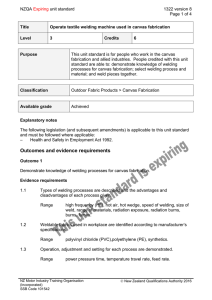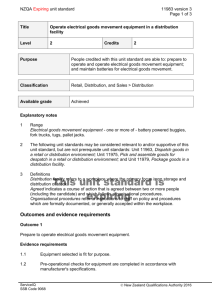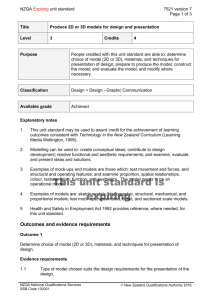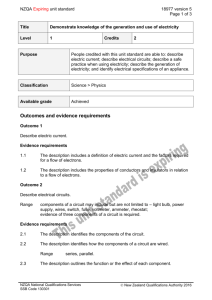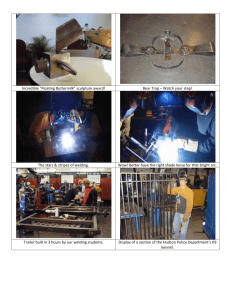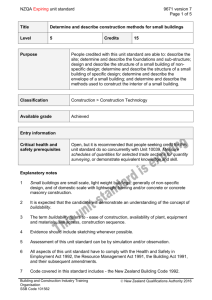913 Use the oxy-acetylene process for welding and allied
advertisement
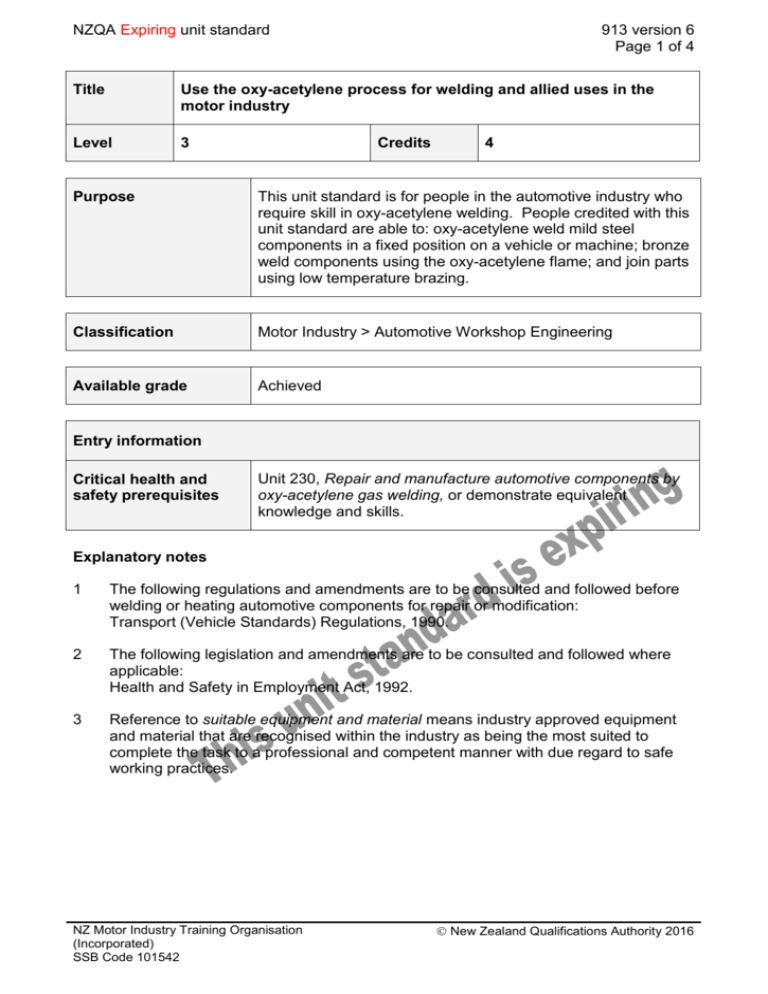
NZQA Expiring unit standard 913 version 6 Page 1 of 4 Title Use the oxy-acetylene process for welding and allied uses in the motor industry Level 3 Credits 4 Purpose This unit standard is for people in the automotive industry who require skill in oxy-acetylene welding. People credited with this unit standard are able to: oxy-acetylene weld mild steel components in a fixed position on a vehicle or machine; bronze weld components using the oxy-acetylene flame; and join parts using low temperature brazing. Classification Motor Industry > Automotive Workshop Engineering Available grade Achieved Entry information Critical health and safety prerequisites Unit 230, Repair and manufacture automotive components by oxy-acetylene gas welding, or demonstrate equivalent knowledge and skills. Explanatory notes 1 The following regulations and amendments are to be consulted and followed before welding or heating automotive components for repair or modification: Transport (Vehicle Standards) Regulations, 1990. 2 The following legislation and amendments are to be consulted and followed where applicable: Health and Safety in Employment Act, 1992. 3 Reference to suitable equipment and material means industry approved equipment and material that are recognised within the industry as being the most suited to complete the task to a professional and competent manner with due regard to safe working practices. NZ Motor Industry Training Organisation (Incorporated) SSB Code 101542 New Zealand Qualifications Authority 2016 NZQA Expiring unit standard 913 version 6 Page 2 of 4 Outcomes and evidence requirements Outcome 1 Oxy-acetylene weld mild steel components in a fixed position on a vehicle or machine. Range vertical weld, overhead weld. Evidence requirements 1.1 Safe working practices are observed throughout the task. Range 1.2 personal safety, safety of others, equipment and vehicle safety. The components are prepared to ensure a sound basis for welding. Range removal of rust and scale, abutting ends square, suitable gap between the joint edges where full root penetration is required, components positioned in-situ. 1.3 Heat shielding of adjacent vehicle or machine components is carried out to prevent any damage and risk of fire and explosion. 1.4 The components are welded in the desired position. Range 1.5 safety precautions taken, appearance of weld bead, full root penetration where required, no lack of fusion, no pin holes, parent metal not undercut, no excessive filler deposits (more than 1.5 mm above original surface), no leakage occurring through the weld. The welding equipment is stored safely after use. Range prevention of damage to equipment and injury to people. Outcome 2 Bronze weld components using the oxy-acetylene flame. Evidence requirements 2.1 Safety precautions are followed throughout the welding process. Range safety of the operator, the plant, nearby personnel. 2.2 Suitable equipment and material are selected and used to enable components to be bronze welded. 2.3 Preparatory work on the components is carried out to ensure a sound basis for welding. NZ Motor Industry Training Organisation (Incorporated) SSB Code 101542 New Zealand Qualifications Authority 2016 NZQA Expiring unit standard Range 2.4 913 version 6 Page 3 of 4 cleanliness, joint preparation, pre-heating, positioning of components. The welding operation is completed having full root penetration, neat appearance, and minimal distortion of the components. Range welding operation – protection of the components, pre-heating, flux application and metal tinned, heat localised, welding technique used, precautions against fumes, post-heating, cooling of the job. 2.5 Bronze overlay allows a layer of 1.5 mm minimum of bronze. 2.6 A rebuilt hole is dressed and drilled to the original size. Outcome 3 Join parts using low temperature brazing. Range brazing in the temperature range 600-850°C using filler metals consisting of predominantly silver and copper. Evidence requirements 3.1 Safety precautions are followed throughout the brazing process. Range safety of the operator, the plant, nearby personnel. 3.2 Suitable equipment and material are selected and used to enable components to be brazed. 3.3 Preparatory work on the parts is carried out to ensure a sound basis for welding. Range 3.4 joint design, cleanliness, joint gap within the range 0.04 – 0.25 mm. The brazing operation is completed having neat appearance and minimal distortion of the components. Range joint appearance, strength, ductility, finish. This unit standard is expiring. Assessment against the standard must take place by the last date for assessment set out below. NZ Motor Industry Training Organisation (Incorporated) SSB Code 101542 New Zealand Qualifications Authority 2016 NZQA Expiring unit standard 913 version 6 Page 4 of 4 Status information and last date for assessment for superseded versions Process Version Date Last Date for Assessment Registration 1 29 October 1993 31 December 2016 Review 2 4 October 1996 31 December 2016 Review 3 26 February 1999 31 December 2016 Review 4 20 March 2008 31 December 2020 Rollover 5 19 November 2010 31 December 2020 Rollover 6 22 August 2014 31 December 2020 Consent and Moderation Requirements (CMR) reference 0014 This CMR can be accessed at http://www.nzqa.govt.nz/framework/search/index.do. Please note Providers must be granted consent to assess against standards (accredited) by NZQA, before they can report credits from assessment against unit standards or deliver courses of study leading to that assessment. Industry Training Organisations must be granted consent to assess against standards by NZQA before they can register credits from assessment against unit standards. Providers and Industry Training Organisations, which have been granted consent and which are assessing against unit standards must engage with the moderation system that applies to those standards. Requirements for consent to assess and an outline of the moderation system that applies to this standard are outlined in the Consent and Moderation Requirements (CMR). The CMR also includes useful information about special requirements for organisations wishing to develop education and training programmes, such as minimum qualifications for tutors and assessors, and special resource requirements. NZ Motor Industry Training Organisation (Incorporated) SSB Code 101542 New Zealand Qualifications Authority 2016
